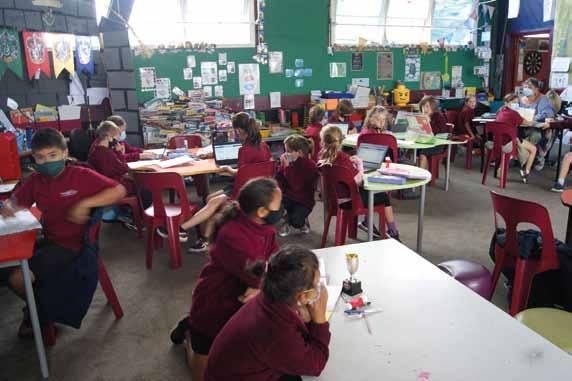
14 minute read
WESTPORT NORTH SCHOOL CULTURE CHANgE
Making a difference
Teacher Sharee Ineson, explains how Cambridge Global Perspectives is equipping students with a wealth of transferable skills while they develop as active global citizens
Cambridge Global Perspectives is an innovative and exciting skills-based programme for students aged 5 to 19 at every stage of the Cambridge Pathway – from Cambridge Primary through to Cambridge A Level. “The course gives students the skills and passion to be active global citizens both now and in the future,” says Sharee Ineson, Teacher, Cambridge IGCSE Global Perspectives at Southland Girls’ High School in Invercargill, Southland, New Zealand. “Through relevant and meaningful inquiry into global issues, they develop critical and creative thinking skills, while gaining a deeper understanding and insight into perspectives at a global, national and local level.”
Topic-based learning with relevance
Cambridge IGCSE Global Perspectives is built around a broad list of topics, each of which encompasses issues of global importance. Students explore topics that have the most relevance to them and complete a written examination, individual report and team project. “Students develop a confidence and self-belief that they can make a difference and their voice is valid and valued in a global society,” says Sharee. Recent projects that Sharee’s students have focused on include the use of animals to reduce anxiety and roleplay simulation games about different journeys refugees may face. “Students’ prior knowledge and interest in topics are encouraged and developed, as are their preferred ways of learning,” says Sharee. Many projects in class link to the United Nations Sustainable Development Goals (SDGs) with a recent example focused on making a ‘to do’ list for the world, incorporating photography and giant post-it notes. “It connects to the syllabus topic Conflict and Peace, but I also connect the Cambridge IGCSE components to the SDGs as I’ve noticed many universities are incorporating these SDGs into courses,” explains Sharee.
Opportunities for increasing engagement
Sharee builds on opportunities to use “the teachable moments where ideas come out of discussions and relevant current events”. She cites travelling festival of art The Walk (walkwithamal.org), featuring ‘Little Amal’ – a giant puppet of a young refugee girl created to represent all displaced children. Last year, Little Amal travelled over 8,000km from the Syria-Turkey border across nine countries. “When we found this project, the engagement levels increased and shifts in students understanding deepened,” says Sharee. Having a shared language with Cambridge Global Perspectives classes in other schools is also valuable, she says: “Knowing they are part of a connected world brings a sense of belonging outside of our classroom.”
The benefits of teamwork
The teamwork component of Cambridge Global Perspectives develops a wide range of skills, says Sharee:
“Using logical reasoning, research and creative thinking skills, group work opens up new options that were not clear as pathways beforehand. Students feel valued for their strengths, and the power of like minds builds an environment of collaboration, where diversity brings possibilities. “If you were to visit any of our Global Perspectives classes, you would see a range of perspectives and opinions. By considering different experiences and perspectives in a group, students develop themselves as innovators.”
Developing transferable skills
Students also produce an individual report and Sharee says this chance to study in depth as an individual brings a sense of ownership and accomplishment: “Time management, communication and research skills are all developed and within the context of the student’s individual report topic. As students reflect on their learning and develop their personal voice, their confidence in themselves as a lifelong learner increases. “The course allows students to make meaning in a context that challenges their thinking while still having their learning facilitated and supported by a teacher. They build their resilience and capacity as learners.” Sharee believes the skills students develop have many different applications: “Students I have taught have spoken of transferring their skills into future learning, but equally into career opportunities and leadership roles,” she says. Meeting and collaborating with teaching teams across other Cambridge subjects helps to embed and further develop the skills learnt through Cambridge Global Perspectives, says Sharee: “This allows the Cambridge learner attributes to become a shared language across all areas, therefore strengthening the ultimate goal of students achieving personal excellence.”
Sharee Ineson, Teacher, Southland Girls’ High School in Invercargill, Southland, New Zealand
Collaboration Innovation and creative thinking Reflection Communication
Cambr idge International AS & A Level Critical thinking and problem solving Cambridge Primar y
Cambridge
Global PerspectivesTM Independent research
C amb ridge IGCSE and C amb ridge O Level Cambridge Lower Secon dary
culturE changE at wEstPort north school
Liz Hawes Editor
It is impossible not to be overawed by the Buller. Nature reigns big in these parts. On a 1040-meterhigh bed of rock, sleeps the giant Mount Rochfort, named after John Rochfort (1832–93) a pioneer survey-engineer who conducted mineral surveys of the Buller District.
R OCHFORT BROODILY OVERSEES the town of Westport and shares a plateau with Denniston, famed for its high-grade coal. Remnants of the impossibly steep Denniston incline railway, once an efficient, gravity driven conduit for coal wagons, and locally referred to as the ‘eighth wonder of the world’, are a visible reminder of the industry that built the district. The 1670-meter incline operated from 1880 to 1967 and once provided the only access to the Denniston settlement which was located about halfway up the mountain at the Brakehead.
Coal-mining families endured extreme conditions on the bleak, windswept Denniston. The hard rock landscape ensured no garden would flourish nor grave be dug. In any Westport pub, you will still hear stories of Denniston folk packing their dancing clothes and whizzing down the incline in a coal cart for a bit of social fun in the local town. Similarly, coal wagons hauled up supplies, including mail, clothing and groceries and the dead were taken down the incline for burial in the town cemetery on Utopia Road,
Native flora welcome visitors to Westport North School at the end of which burbles Deadman’s Creek. Only the tough endured the inhospitable conditions on Denniston. Few would have lingered to take in the splendid views of the Tasman Sea and coastal plains which, today, are a tourist’s delight and are clearly visible from the Brakehead.
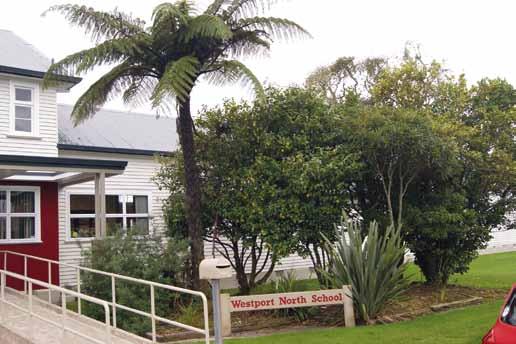
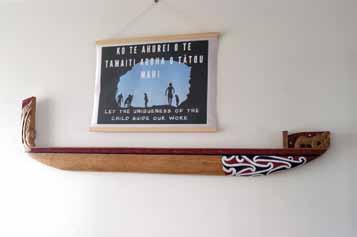
The entrance to the school makes the intentions quite clear The brooding Mt Rochfort watches over the town of Westport
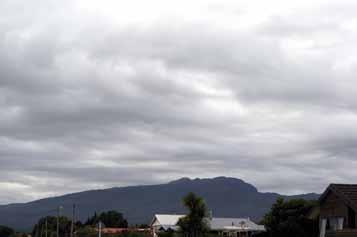
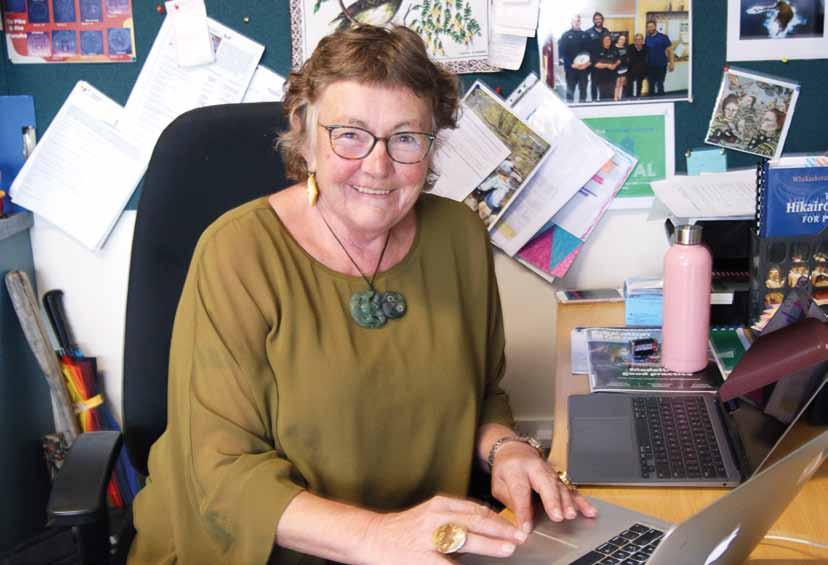
Cath O’Loughlin, Principal of Westport North School
Nor would they have stopped to admire the cloak of dense native bush enveloping their mountainous world. Short of its use as a source of heat and fuel, the pristine podocarp forests, chock full of top-class kahikatea, matai, totara, miro and rimu, tree ferns, vines and ground ferns, were just another barrier to slash through, another force of nature to challenge the pioneering spirit of the intrepid coalminers.
Down on the flat, the town of Westport was not without its environmental threats either. Its proximity to the Southern Alps creates an unusually high rainfall. In keeping with every other giant-sized natural feature of the region, the powerful Buller River is one of our country’s longest and strongest, stretching 170 kms from Lake Rotoiti through the Buller Gorge to empty into the Tasman Sea at Westport. On an average day it flows at 429 cubic meters per second and in flood, holds the record of any New Zealand River at 14,000 cubic meters per second.
The third flood in eight months had just pounded the town of Westport when I visited. It was sad to see so many yellow stickered houses (not safe to inhabit) but the pioneer spirit of ‘roll up your sleeves and get on with it’ was evident everywhere. Some houses were still under repair from the previous flood. It was inspiring to see neighbours helping neighbours clear

The three pou representing the values of Respect, Responsibility and Relationships
On The far side of the garden we can view the pergola. The children learn that they are the Kaitiaki (guardians) of the garden

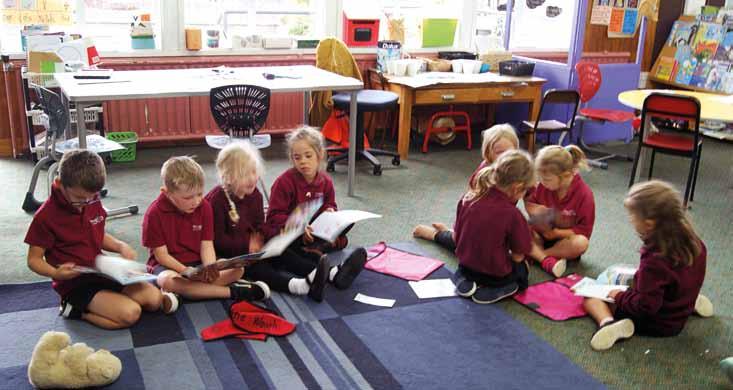
The young ones read to each other
fallen trees, mud, silt and debris. Days before, volunteers had turned out from across the town to help rescue those unable to evacuate in time and temporary accommodation had been brought in for families while houses were repaired. There is no time to dwell on adversity in Westport. When you’re up against it and there’s work to be done, you get on with it.
At the local Westport North School, this same attitude drives the cultural changes being led by principal Cath O’Loughlin. Cath has been principal of Westport North since 2015, after spending four years there as Deputy Principal. It was during her Deputy years that it was decided future generations of young people in Westport can be raised with a full appreciation of tikanga Māori, te reo and a Māori world view. The time was right. Awareness that biculturalism benefitted all New Zealanders was already growing. Parents, particularly of Māori children, wanted their tamariki to feel they
belonged at school and that their Māori culture was not just accepted but actively embraced and valued. The common goal for the school and parents was that Māori children would succeed, not by compromising their culture, beliefs and values, but by practicing them and sharing them with all the children of Westport North School. This latter goal was key. At so many levels, what is good for Māori children is good for all children, and Cath was right on board with that way of thinking. The first step was building a greater appreciation of tikanga Māori with staff. Already there were two teachers fluent in te reo who led the year 1 – 8 bilingual class from 2011. This was a first for Westport. But Child’s impression of their principal, Cath O’Loughlin unfortunately for Cath, these two were in high demand and within a short time had left to take up further responsibilities. For the bilingual class to maintain its momentum, another
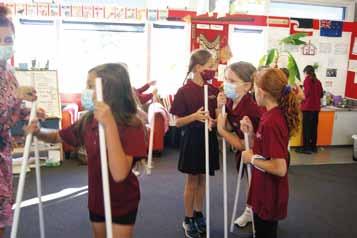
Children get ready to play poi rakau The new entrant numbers are diminished from covid, but these little ones are keen to get on with their writing skills


Practising action songs is part of the whānau class learning Learning to korero to the group
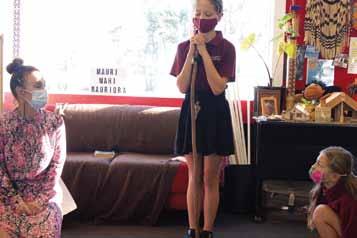
of the permanent teachers moved to Christchurch for a year to complete Hōaka Pounamu, a post-graduate diploma in bilingual teaching.
‘The commitment to this Kaupapa is so strong,’ explained Cath, ‘and for this teacher to take a year away from her family and school showed such dedication to what we are trying to achieve,’ she said.
Cath was clear that a bicultural school wasn’t just about a single class with a teacher. She recognized they needed the entire staff on board to affect the culture change the school was after.
Kaua e rangiruatia te hāpai o te hoe; e kore tō tatou waka e ū ki uta.
Don’t paddle out of unison; our canoe will never reach the shore.
‘This has been a long journey,’ she said, ‘because we wanted everyone heading in the same direction and committed to the same Kaupapa and that takes time.’
It also takes strong relationships and by the time she had taken the principal’s role, Cath was very clear that the local iwi would be fully involved and that her entire school community would understand why the changes were taking place and how everyone would benefit.
Changes began gradually. The school’s values of Respect, Responsibility and Relationships are now described in all the school’s branding and publications as manaakitanga, kaitiakitanga, tohungatanga and rangatiratanga. Three pou stand
PROVIDE A BETTER LEARNING EXPERIENCE

NSL can provide you with the best audio, video and control solutions catered to your school all around New Zealand.
Our expert team can help you custom design and personalise your next campus space, whether it’s a classroom, hall, gym, school bell or paging system.
For more info contact Ryan on 021 750 273 or ryan@nsl.co.nz to discuss any opportunities for your school. Find out more on our website www.nsl.co.nz
Audio Video Control
New Zealand’s most trusted provider of commercial Audio, Video and Control brands
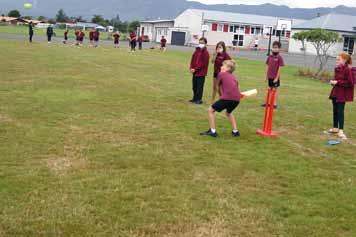
A quick game of cricket to warm up for the day Padder tennis is endless fun while all the time improving coordination and timing

tall at the school’s entrance representing these values. Children across the school were taught the conventions of writing their own pepiha and all classes now begin the school day with a karakia.
I visit the whānau (bilingual) room, which has grown to two classes in the past couple of years. There are normally 22 children in the whānau room but with COVID ravaging the district, fewer than half the children were present. Like every other school in the country, Westport North was suffering high case numbers of the Omicron variant and of the 245 children on the school roll, some 92 were absent.
I enjoy a busy morning in the whānau room. We have our karakia, are addressed by one of the students, who delivers a very comprehensive pepiha, we practice waiata and action songs and play Poi Rākau, a traditional Māori game which helps to build coordination skills. Ka mau te wehi! Fantastic.
I examine the whakapapa map and find that the tamariki
identify with a broad range of iwi. ‘It is important to our tamariki to understand their cultural identity,’ says Cath, ‘and all our tamariki are encouraged and helped to identify what iwi they belong to,’ she said. ‘It gives them pride and heightened esteem to know who they are and where they are from,’ she explained. The students are also given the task of translating an instruction from their teacher relating to the concept of manaakitanga. What would you suggest a visitor might do in Westport? They constructed their list, which was kindly intended for me. It was an impressively balanced list and clearly demonstrated their knowledge and pride for their town. It included physical features such Learning to dribble the hockey as the Lost Lagoon, Kawatiri Coastal River puck Trail, Carter’s beach, the school garden, the Orowaiti river, mussel rock and Denniston; eateries such as Jays Café, the Denniston Dog and the Star Tavern at Cape Foulwind; and places of interest like the Coaltown museum, Denis’s Book Shop and the local library. It was also suggested I might like to browse the Op Shop because everything there is cheap! In the whānau room, te reo is spoken about 50 per cent of the day. What is helpful is that throughout the entire school, te reo is heard in every classroom every day. ‘Korero ki tou hoa’, you might hear in any classroom, meaning, ‘Talk to your friend.’ ‘He pai to mahi,’ a teacher Sports Academy students can take a break for a game of table tennis during the day will be saying to a
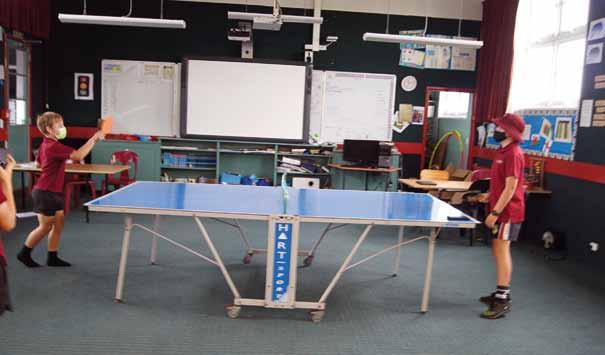
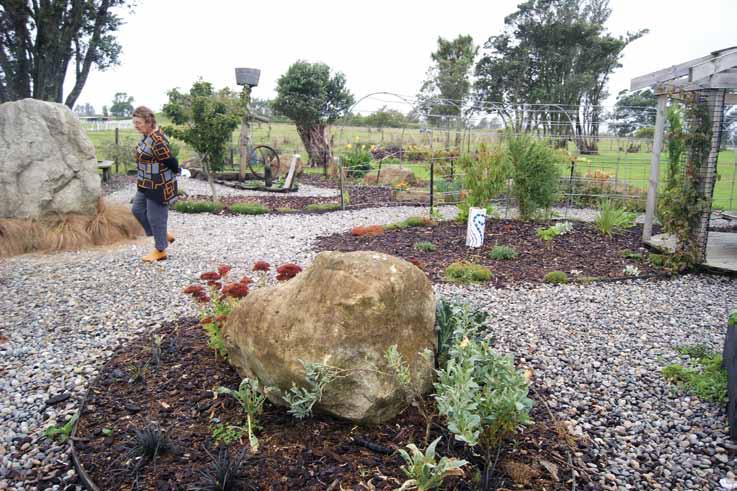
Principal Cath O’Loughlin takes a stroll around the tranquil school garden
At Westport North children work indoors with the doors and windows open to keep the room well ventilated and protect them all from covid
student, meaning, ‘That’s good work.’ Gradually, te reo is becoming more and more common place as the school continues its journey towards biculturalism.
Westport North school has had its fair share of youngsters suffering anxiety and fears not just through the covid pandemic but also because of the floods that have ravaged the district. Children’s wellbeing is therefore prominent at Westport North. The school adopts the concept of hauora which is built on ‘te whare tapa whā’ – the four pillars of the whare. Taha Hinengaro, mental and emotional wellbeing, Taha Wairua, spiritual wellbeing, Taha Tinana, physical wellbeing and Taha whānau, family and social wellbeing. The children can immediately see that all four pillars must be in balance and be strong to hold up the whare and are well versed in the practical implications of each. It is a powerful model and easily relatable for the children.
A new feature of the school is its beautifully designed garden of which both staff and students are very proud.
‘We intend to start growing vegetables for our community in the future,’ says Cath, ‘and the children will gradually become
